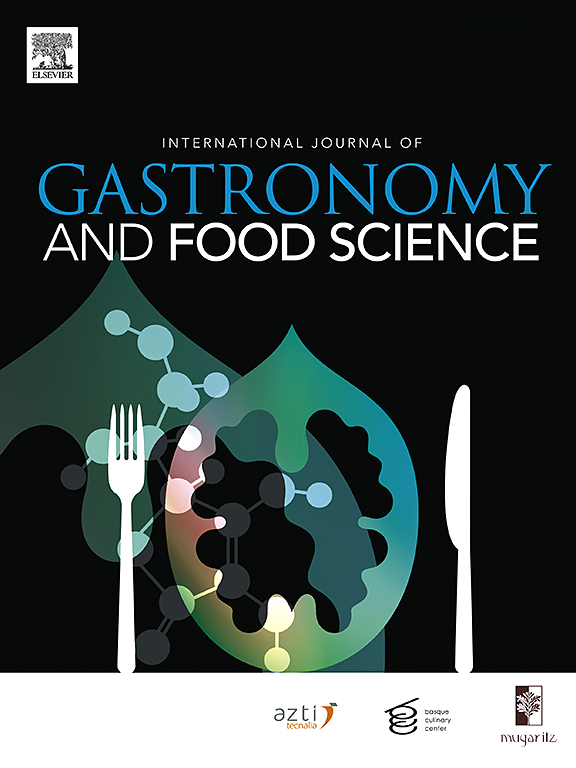Total replacement of egg white by aquafaba and commercial substitute in meringue formulation: Effect on physico-chemical properties and hedonic appreciation
IF 3.2
2区 农林科学
Q2 FOOD SCIENCE & TECHNOLOGY
International Journal of Gastronomy and Food Science
Pub Date : 2025-01-04
DOI:10.1016/j.ijgfs.2025.101103
引用次数: 0
Abstract
This paper deals with the total substitution of egg white (EW) with chickpea cooking water “Aquafaba” (AQ), a commercial egg white replacer (CEWR), and their mixture (1/1) (w/w) in the formulation of flavored French meringue. The physico-chemical and techno-functional characterization of both ingredients showed that AQ, had a higher foaming property than that of CEWR. AQ-based formulation had the lowest density (0.640 g/mL), viscosity (84000 mPa.s), and hardness (0.14 N) before cooking, leading to the firmest meringue (80.23 N) compared to formulations made only with CEWR or CEWR and AQ together. In the sensory evaluation, all descriptors had the highest score for the formulation based on AQ exceeding those of EW-based formulation. All results confirmed well the success of the substitution of egg white by AQ in the meringue formulation and showed that AQ, considered as an industrial waste, could be used instead of the CEWR having a higher cost compared to AQ.

蛋清在蛋白蛋白配方中的完全替代:对理化性质和欣赏性的影响
本文研究了用鹰嘴豆煮水“Aquafaba”(AQ)和一种商用蛋清替代品(CEWR)完全替代蛋清(EW)及其混合物(1/1)在风味法式蛋白霜配方中的应用。对两种原料的理化和工艺功能表征表明,AQ具有比CEWR更高的发泡性能。与仅添加CEWR或CEWR与AQ的配方相比,以AQ为基础的配方在蒸煮前具有最低的密度(0.640 g/mL)、粘度(84000 mPa.s)和硬度(0.14 N),可获得最牢固的蛋白霜(80.23 N)。感官评价中,以空气质量为基础的配方的所有描述符得分均高于以空气质量为基础的配方。所有结果都很好地证实了AQ在蛋白蛋白配方中替代蛋清的成功,并表明AQ作为一种工业废物,可以代替成本高于AQ的CEWR。
本文章由计算机程序翻译,如有差异,请以英文原文为准。
求助全文
约1分钟内获得全文
求助全文
来源期刊

International Journal of Gastronomy and Food Science
Social Sciences-Cultural Studies
CiteScore
5.30
自引率
10.50%
发文量
170
审稿时长
45 days
期刊介绍:
International Journal of Gastronomy and Food Science is a peer-reviewed journal that explicitly focuses on the interface of food science and gastronomy. Articles focusing only on food science will not be considered. This journal equally encourages both scientists and chefs to publish original scientific papers, review articles and original culinary works. We seek articles with clear evidence of this interaction. From a scientific perspective, this publication aims to become the home for research from the whole community of food science and gastronomy.
IJGFS explores all aspects related to the growing field of the interaction of gastronomy and food science, in areas such as food chemistry, food technology and culinary techniques, food microbiology, genetics, sensory science, neuroscience, psychology, culinary concepts, culinary trends, and gastronomic experience (all the elements that contribute to the appreciation and enjoyment of the meal. Also relevant is research on science-based educational programs in gastronomy, anthropology, gastronomic history and food sociology. All these areas of knowledge are crucial to gastronomy, as they contribute to a better understanding of this broad term and its practical implications for science and society.
 求助内容:
求助内容: 应助结果提醒方式:
应助结果提醒方式:


